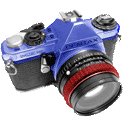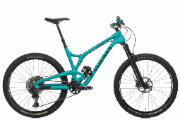|
red19fire posted:I used to think my D7000 AF was faulty because I was missing focus constantly on the 85mm 1.4 AIS. It turns out that the widest aperture that Nikons will use in focusing is 2.8, so as long as the 2.8 DOF is focused, the green dot lights up. However, if your aperture is faster than that, it will open up the aperture upon shutter release, and the 1.4 DOF area falls where it may. It might be incorrect, that's how it was explained to me. red19fire posted:It's weird to explain. Using an AIS lens, i twist the focus so that the focal plane is in front of the subject, then gradually focus towards the subject until the green light comes on. So if you were looking at my focus scale, I turn it so it goes from 7' to 10' (with the subject at 10 feet); rather than 13' to 10'. When the lens stops up from 2.8 to 1.4, it's more likely to have the correct area in focus. I find this to be the better way of That's interesting, I've got a 105mm 1.8 I've been playing with and sometimes the focus does feel wacky & off like you describe. I'll give your technique a shot next time I use it and see how that works. Thanks!
|
|
|
|

|
| # ? May 8, 2024 23:01 |
|
On the 85 1.4 AIS, I can twist the focus 1-2 degrees and still keep the green dot lit. It also has to do with how focal planes work. Since the area of best focus is about a third behind the front limit of the acceptable focus area, focusing "front to back" ensures that you're more likely to fall within the middle third where you'll get the best focus when the focal plane's depth halves going from f/2.8 to 1.4.  To continue on with Remo's explanation, as I understand it the AF module needs at least 2.8 to have enough contrast to tell whether or not something is in focus, and the focal plane at 1.4 is just too thin (less than a quarter of an inch for a portrait; you can have eyes in focus, but not eyebrows). There's also user error, if the subject breathes or you move the camera a tiny bit when you hit the shutter it can disturb the focal plane. Which is why I tend to spray'n'pray with super-fast lenses; on the LCD it might seem like it's in focus, but viewed properly in LR it might be just slightly OOF. Speaking of awesome lenses, does anyone have the 105mm or 135mm DC lenses? I would kill a man for one of them.
|
|
|
|
Remo posted:I have read somewhere before that the AF sensors in Nikon AF modules are taking readings from an area equivalent to an f5.6 aperture. I.E. they are measuring if the lens is being stopped down to f5.6, even when it is not. Some Canon DSLRs, like the 7D and the 5DII, have f2.8 sensitive AF sensors which are taking readings from an f2.8 area, but there aren't any Nikon cameras with this feature AFAIK. I'm basically sure that Nikon cameras are AF sensing at 2.8, not 5.6. Unless of course you have a lens in which the largest aperture is 5.6. Where did you read that Nikon can't AF at 2.8?
|
|
|
|
This is where I had got it from, I should have posted this in the first place http://www.dpreview.com/forums/post/50045281 She also did some testing of her own http://www.dpreview.com/forums/post/50073569
|
|
|
|
tijag posted:I'm basically sure that Nikon cameras are AF sensing at 2.8, not 5.6. Unless of course you have a lens in which the largest aperture is 5.6. Where did you read that Nikon can't AF at 2.8? Probably mis-read the bit where AF is only guaranteed at apertures of 5.6 or faster (hence possibly losing AF performance when using a not-so-fast lens with a TC).
|
|
|
|
Not really sure where to post this seeing as it's somewhat of a unique situation. I need to record something super small, emitting a lot of light, and I've got to do it while shooting through a comically small window. Figure below. Little green dude is about 1/4" wide, but I need to resolve features at the ~100 micron scale at least. The distance from the green thing to the outer edge of the window is about 6 in.  Requirements: Must mount to Nikon F-mount Looking to keep cost under ~$1500-2000 but not a big deal if one option is a couple hundred more than another Manual focus and manual aperture control on lens (high-speed camera that cost $30k can't control lens aperture or focus...) Once it's set up, it won't move so it can be as unwieldy as you like My first iteration with some rental equipment used a series of Kenko extension tubes plus a Zeiss Zf.2 100mm lens yielded decent results but I'd like to see if I can get even better results before I commit to purchasing equipment. Video screenshot below taken with 12mm+36mm tubes in series plus the lens at a stop or two above smallest aperture on the lens.  Many thanks!
|
|
|
|
Hmm, My first bet if you're looking at the micron scale would be to look at a microscope, but that's probably a bit of overkill, plus I'm not sure you'd be able to focus on something 6" away. I'd probably look into getting a set of bellows instead of extension tubes, they'll give you a lot more flexibility, other than that I'm not sure. If you start getting more resolution you're probably going to start losing DoF. But really, that 6" working distance is probably going to be the limiting factor. A canon mp-e would get you down to 100 micron pretty easily from what I've read online, and a good reversed prime lens on the bellows can probably get close too, maybe a microscope element at the end like some people in the macro thread were doing (I believe people were stacking photos like mad though, probably can't do that with an action shot!). With any of those you're probably looking at less than 6" of working distance though. Is the 6" the distance from the thing reacting to the window, or from the window to the closest you can get to the box? Also if the window is made of crappy glass/plastic that could make things harder to resolve too. Might also want to consider using an ND filter instead of stopping way down on the lens, depending on whether DoF or diffraction is giving you more issues (if you're stopping down to f/22 you're going to likely be losing some detail in exchange for getting more in focus). e. to be clear if you're reverse mount a lens onto the bellows you're probably going to want to reverse mount something wider than the 100mm, If I remember right my pentax 67 75mm/4.5 lens reverse mounted gave me about 6" of working distance but I'm not sure I got down to 100 microns of resolution either. I knew I should have photographed my calibration slide while I was at it. :| Dr. Despair fucked around with this message at 22:26 on Apr 11, 2013 |
|
|
|
You could also try a reversed 50mm on the end of a long telephoto using a coupling ring, although I'm not sure how much better results you'd get than with your current setup.
|
|
|
|
Errant911 posted:Not really sure where to post this seeing as it's somewhat of a unique situation. I need to record something super small, emitting a lot of light, and I've got to do it while shooting through a comically small window. Figure below. Your situation calls for both extreme magnification and extreme working distance. The only way to achieve that is with long focal lengths. Forget the $2k 100 mm lens. Get a 200 mm macro and a 2◊ teleconverter. Pile on extension tubes or bellows (it will take a lot with a lens that long) till you cannot get closer to the glass. Use a DX camera if you can. Platystemon fucked around with this message at 10:17 on Apr 12, 2013 |
|
|
|
Yo Nikon nerds I posted a bunch of Nikon stuff for sale in the thread.
|
|
|
|
Errant911 posted:Requirements: You could also consider using a teleconverter on a dedicated macro lens. This will increase your minimum working distance at the same magnification e: will read posts more thoroughly in future before responding. Dia de Pikachutos fucked around with this message at 09:26 on Apr 12, 2013 |
|
|
|
He doesn't need body aperture control.
|
|
|
|
Thanks everyone for the really great suggestions so far. I may be getting a little ambitious with the ~100 micron resolution, and if I can't realistically get down that low with standard photography equipment, I could live with that. Honestly, the results I've gotten so far are better than I expected. When I was first taking test videos with the above rental equipment, I expected it to be an issue of not enough light rather than too much. In fact, it still may be an issue as I push the fps above what that test snapshot was taken at, 2000 or 3000 fps IIRC. I'd really like to freeze the image of the particles lifting off the surface. I may need to push up to 5000-10000 fps, but 2000 is the limit where the camera can still record at its max resolution, 1024x1024. I'm going to start reading up on some of the advantages/disadvantages of using teleconverters vs. macro bellows, and try to start picking out parts. I'm just crazy swamped and preparing for a big out of state interview early next week.
Errant911 fucked around with this message at 22:58 on Apr 12, 2013 |
|
|
|
Errant911 posted:Thanks everyone for the really great suggestions so far. I may be getting a little ambitious with the ~100 micron resolution, and if I can't realistically get down that low with standard photography equipment, I could live with that. Honestly, the results I've gotten so far are better than I expected. When I was first taking test videos with the above rental equipment, I expected it to be an issue of not enough light rather than too much. In fact, it still may be an issue as I push the fps above what that test snapshot was taken at, 2000 or 3000 fps IIRC. I'd really like to freeze the image of the particles lifting off the surface. I may need to push up to 5000-10000 fps, but 2000 is the limit where the camera can still record at its max resolution, 1024x1024. I'm going to start reading up on some of the advantages/disadvantages of using teleconverters vs. macro bellows, and try to start picking out parts. I'm just crazy swamped and preparing for a big out of state interview early next week. No one's picked up on the fact that you want to shoot little green dudes? Do you work for Area 51?
|
|
|
|
Legitimate Pape posted:Any updates on the D600 dirty sensor issue? Mostly, are recent new or refurbished cameras still affected? I'm thinking about upgrading but don't want to deal with the hassles I heard of. Just gonna bump this. I find conflicting information all over online.
|
|
|
|
I think almost every brand new camera Nikon makes has this problem, they put too much oil on the shutter springs which tends to fleck off with use. I got a D7000 brand new when they first came out and I had to swab the sensor twice during a wedding, there were gobs of oil on it. Really the best advice is to get good at using Sensor Swabs, it takes about 5-10k shutter actuations until all the excess shakes off and is a good thing to know in general anyway. IIRC, people were sending their cameras out to Nikon for CLA's at like 2k actuations and I think Nikon just wiped the sensors and not the springs, since the lubricant has to last for 150k+. I think your best bet is to wait a few months for people to start putting mileage on their cameras. The FM
|
|
|
|
I'm sending mine off to Nikon this week. I've only noticed it in very rare cases (really white/cloudy sky shots at f8-f22), but it's enough to where I don't want to worry about it (and it's a LOT of oil). Plus I have 3 weeks of downtime and some new equipment coming in so I'm going to take advantage of the time.
|
|
|
|
Cleaned mine off once around 5k, never had issues after.
|
|
|
|
BonoMan posted:I'm sending mine off to Nikon this week. I've only noticed it in very rare cases (really white/cloudy sky shots at f8-f22), but it's enough to where I don't want to worry about it (and it's a LOT of oil). Plus I have 3 weeks of downtime and some new equipment coming in so I'm going to take advantage of the time. Does Nikon cover sensor cleanings, and what kind of turnaround time are they quoting? Either way I'm tempted to pay to have a camera shop do it locally since they can do it in a day.
|
|
|
|
1st AD posted:Does Nikon cover sensor cleanings, and what kind of turnaround time are they quoting? Either way I'm tempted to pay to have a camera shop do it locally since they can do it in a day. No charge for me I don't think (they didn't indicate there would be one...except maybe shipping?). I showed them video and pic evidence and basically got a "hmmm yes I see it. Send it in and we'll fix it" response but I haven't finished filling out the form. I wanted to get a local shop to do it but the only local shop here said they don't clean full frame sensors. ooookkkayyy.
|
|
|
|
Having a weird issue with my D800. Sometimes during when I'm recording movies during live view, the screen will give a weird flash that looks either like a still frame sortof filling the screen differently, maybe with some pink bands of blockiness. I never noticed it till before but I've also been shooting a lot of video recently. It's so fast I thought it was in my head for a while, but now it's happened enough times that I'm sure it's real. Has anyone else encountered something like this? I don't want to send it back and wait a month for Nikon to tell me they couldn't find anything.
|
|
|
|
Okie doke, so things have been crazy lately, but I've finally been able to look at some lenses and attachments. The biggest difficulty I'm having is calculating maximum working distance when I deal with the series of lenses + attachments. In other words, how do I find max WD when I've got a 100mm macro 12mm+36mm extension tubes. I want to make sure I can be far enough away from my subject to be outside the 6 in limit imposed by trying to shoot from outside the test structure (see figure in above post). Additionally, I'm trying to make sure my DoF isn't ridiculously narrow. I'm considering the following possibilities at the moment. I'm no longer obsessing over intense magnification. If I can get a little better than what I was getting previously, I'm pretty sure factors outside of lens choice are going to prevent me from getting that resolution. Lenses
Extension Tube/Bellows
|
|
|
|
I think you've got your DOF numbers backwards. It's smaller apertures, down near f/8 to f/11 where you get wide depth of field. If you're shooting at f/2.8, your depth of field will be razor thin. Your depth of field is directly proportional to X, where your aperture is f/X.
|
|
|
|
|
a foolish pianist posted:I think you've got your DOF numbers backwards. It's smaller apertures, down near f/8 to f/11 where you get wide depth of field. If you're shooting at f/2.8, your depth of field will be razor thin. Your depth of field is directly proportional to X, where your aperture is f/X. Was this in response to my post? If so, I wasn't implying that I would be shooting at f/2.8, I was just providing lens names. I'll stop down quite a bit to increase the DoF, at least to f/11 or f/16. I meant that the Tamron would have a larger DoF at equivalent f-number and focusing distance because it has a shorter focal length.
|
|
|
|
Depth of field for a given magnification and aperture is not dependent on focal length. For instance, a 180mm macro lens at 1:1 has the same depth of field as a 90mm macro lens at 1:1, all other things being equal. Where the longer focal lengths matter is in working distance, since achieving the same magnification with a shorter focal length requires a commensurate reduction in distance to the subject. Since this is the critical factor in your work, then longer focal lengths are going to be better for your application. A quick test with my PB-6 bellows and a 135mm lens shows I can get ~1.5-2x magnification at full extension with around 200mm of working distance. There is a chart at the back of the Nikon PB-6 manual that has some common extension/working distance numbers that might be helpful. You can get the manual here: http://www.cameramanuals.org/nikon_pdf/nikon_pb-6_bellows.pdf
|
|
|
|
spongepuppy posted:Depth of field for a given magnification and aperture is not dependent on focal length. For instance, a 180mm macro lens at 1:1 has the same depth of field as a 90mm macro lens at 1:1, all other things being equal. This is the right answer. The shorter lens has to get closer to the subject, which cancels out with the focal length difference to yield the same depth of field. If your requirements remain unchanged, specifically manual aperture and manual focus, I donít see why youíre considering automatic extension tubes. Go with manual tubes that are literally less than  on eBay. Those tubes are actually more solid than the expensive ones because they screw together rather than chaining bayonet mounts. on eBay. Those tubes are actually more solid than the expensive ones because they screw together rather than chaining bayonet mounts.The Novoflex bellows would be a mistake no matter what. Youíd be paying an enormous premium for autofocus and auto aperture that only work on Canon cameras. If you want bellows, manual ones start at $35 for generic brands. If you want higher mechanical quality, vintage bellows are available for $100 and up. As for lenses, go for the 180 mm or 200 mm for better working distance. The focal length difference between the two is fairly negligible. According to published specifications, working distance for the 200 mm lens is 26 cm to the 180ís 25 cm. Nikonís lens is optically superior, but not necessarily to the tune of $700. Working distances must be determined empirically because macro lenses are far from idealised thin lenses. In most macro lenses at 1:1, the front element is far from the optical centre and the focal length diverges markedly from the nominal value.
|
|
|
|
spongepuppy posted:Depth of field for a given magnification and aperture is not dependent on focal length. For instance, a 180mm macro lens at 1:1 has the same depth of field as a 90mm macro lens at 1:1, all other things being equal. Ah okay, I realize where I went wrong (more than one place). For one thing, I left out key info about my assumptions. First, I should have used "working distance" rather than "focusing distance." Also, I didn't mean to imply magnification would be the same between a 200mm and a 180mm at the same WD. I only meant that the DoF would be larger for the shorter focal length lens (assuming same f#) at the same working/focusing distance. Wouldn't it? I might be totally wrong, but I got the "larger DoF" from using online calculators. I would put in a focusing/working distance, e.g. 25 cm, and a random f#, e.g. f/16, and I was varying lens focal length, 100, 180, 200mm. I was seeing the DoF grow with decreasing focal length. I didn't mean to imply magnification would be the same, just that DoF would grow as focal length decreased (and magnification decreased). While sufficient magnification is a concern, a super narrow DoF would also make a setup unsuitable for my purposes. I need at least a few mm, ideally at least 4-5mm, but I'm starting to understand I really need to sacrifice magnification to get that. I was able to get a decent DoF when I was shooting with the 100mm Zeiss Zf.2 + 12mm + 36mm extension tubes, at like ~f/16-f/22. Platystemon, I'll look for those manual tubes. I've been checking places like Adorama and B&H, mainly because of how my university/research lets us do billing. I can't order from Amazon or ebay unless I put it on my own credit card then get reimbursed at a later date. I understand how ridiculous that sounds, but that's what I have to work with. Right now, I think I'm going to go with the Tamron 180mm unless I find a higher quality alternative that isn't twice the price like the 200mm Nikon. I'll also look for some cheap manual bellows or extension tubes somewhere. Errant911 fucked around with this message at 23:48 on Apr 22, 2013 |
|
|
|
Errant911 posted:For one thing, I left out key info about my assumptions. First, I should have used "working distance" rather than "focusing distance." Also, I didn't mean to imply magnification would be the same between a 200mm and a 180mm at the same WD. I only meant that the DoF would be larger for the shorter focal length lens (assuming same f#) at the same working/focusing distance. Wouldn't it? You know sometimes photograph looks sharp in a thumbnail, but when you look at a larger version, itís out of focus? Thatís how it works with magnification. Youíll get the same depth of field cropping a low‐magnification image as you would resizing a high‐magnification image to the same dimensions, or at least you will after diffraction is taken into account. Thereís nothing to be gained by intentionally limiting magnification. Youíre not going to get 5 mm of field depth even at f/32. Consider focus stacking if the little green dude is a static subject. Spend the universityís money on one of these. The boring alternative is to use a manual macro rail. Ask about stacking software and technique in the macro thread. Adorama sells the same tubes as eBay for
|
|
|
|
Errant911 posted:Ah okay, I realize where I went wrong (more than one place). As a warning, don't buy the Micro-Nikkor 200mm f/4 AI-S because it's a huge purple fringing piece of poo poo (I used to have one).
|
|
|
|
SoundMonkey posted:As a warning, don't buy the Micro-Nikkor 200mm f/4 AI-S because it's a huge purple fringing piece of poo poo (I used to have one). It also only focuses to 1:2.
|
|
|
|
SoundMonkey posted:As a warning, don't buy the Micro-Nikkor 200mm f/4 AI-S because it's a huge purple fringing piece of poo poo (I used to have one). Lightroom 5 fixes that
|
|
|
|
Is there any such thing as a split-focus screen for the D600?
|
|
|
|
Phanatic posted:Is there any such thing as a split-focus screen for the D600? Katzeye makes them, but not for the D600 yet. I have one for the D700, and it's okay, but I end up using AF with my AIS lenses anyway. I think I need to shim mine, because it's either off by a hair or my eyesight is horrible.
|
|
|
|
Phanatic posted:Is there any such thing as a split-focus screen for the D600? Not yet. Katzeyes should have one sooner than later.
|
|
|
|
Musket posted:Not yet. Katzeyes should have one sooner than later. There is actually a "Bresson" brand screen on ebay but from the reviews posted so far the quality isn't anything to write home about. Katzeye apparently is having issue sourcing parts (D600/800 being 100% viewfinders) so it may be some time if ever that they offer one.
|
|
|
|
Platystemon posted:You know sometimes photograph looks sharp in a thumbnail, but when you look at a larger version, itís out of focus? Thatís how it works with magnification. Youíll get the same depth of field cropping a low‐magnification image as you would resizing a high‐magnification image to the same dimensions, or at least you will after diffraction is taken into account. Thereís nothing to be gained by intentionally limiting magnification. Sadly, the object I'm filming is not static, so I doubt focus stacking will work. The object is in the process of burning while I film. I'm actually using a high-speed video camera to capture the transient nature of the burning surface. If you look at my test image, you can sorta see what's going on. I may upload a short video to give a better idea of what it looks like. I was able to get sufficient DoF with the original setup so I may look back to that level of magnification. The Zeiss 100mm lens had max mag of 1:2, then I tacked on a couple extension tubes and was able to get good results without too much damage to dof. The focus stacking is a really cool concept, and if I wasn't working with such a far from ideal specimen, I'd definitely go with that option.
|
|
|
|
You should maybe try posting your question here: http://forums.somethingawful.com/showthread.php?threadid=3531746 To me it sounds like you're trying to record some science type stuff, and they might have better idea how to do it there. If I'm totally off base the never mind.
|
|
|
|
My brother has one of these: http://forum.mflenses.com/panagor-auto-wide-angle-f2-35mm-t41867.html Will this mount to my D7000? Do I need an adapter? Edit: looks like I need an M42 -> nikon f adapter. Are there any good/bad to watch out for? FistLips fucked around with this message at 07:24 on Apr 24, 2013 |
|
|
|
Anyone here have experience with the 85mm f2 AI? They're pretty cheap on KEH and I was thinking of picking one up. In other news: I'm selling a 70-200 2.8 VRII in the buy/sell thread if anyone's interested.
|
|
|
|

|
| # ? May 8, 2024 23:01 |
|
powderific posted:Anyone here have experience with the 85mm f2 AI? They're pretty cheap on KEH and I was thinking of picking one up. Assuming you're OK with manual focus lenses (and your body will meter non-CPU lenses!) then the question is basically just whether you like the focal length. Nikon didn't really put out any short-tele prime lenses that I'd consider dogs, and that lens (along with the 105/2.5) goes way back - literally as long as Nikon has been making cameras (back to the early rangefinder days). Paul MaudDib fucked around with this message at 23:27 on Apr 24, 2013 |
|
|


























